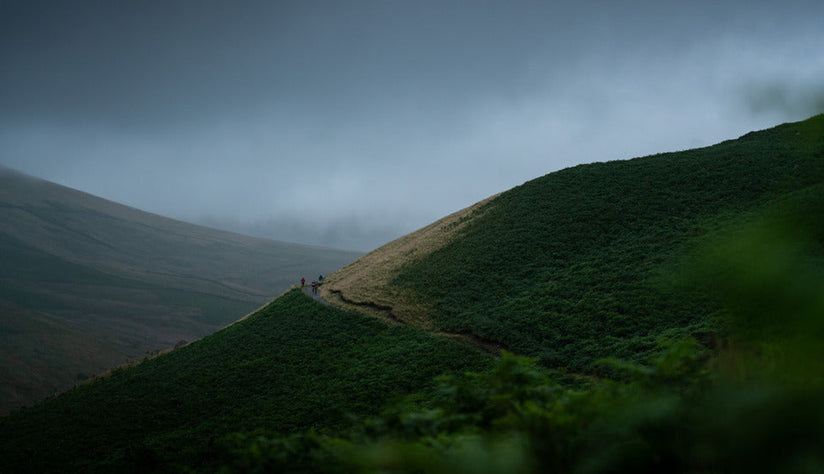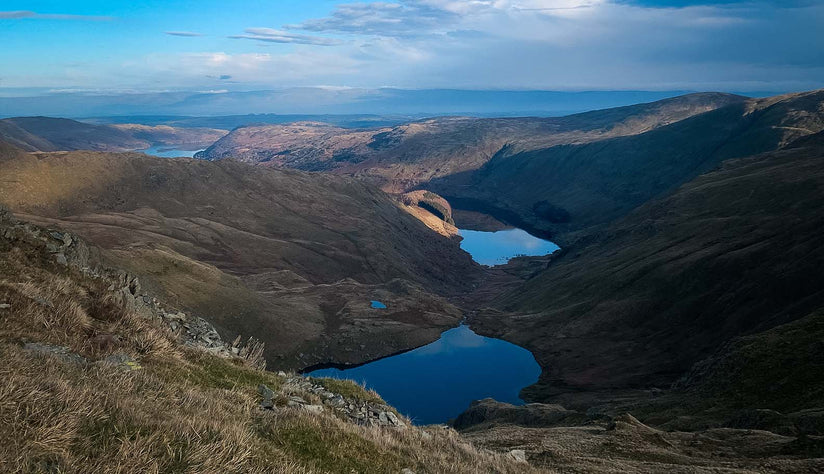Photo Credit: No Limits Photography
Welsh folklore may have inspired the name of the Dragon’s Back Race, but the trails conquered on this mountainous multi-stage journey are anything but myth. With 17,400m of ascent and 380km to cover, endless ridge lines and challenging environments push those taking part to their absolute limit. Spanning over 6 days, racers must navigate all the way from Conwy Castle in the North of Wales to Cardiff Castle in the South. In between, they’ll traverse some of Wales’ most rugged landscapes, taking on iconic mountain peak after iconic mountain peak. All this whilst battling the ever changeable Welsh elements…
For the brave few who manage to make it all the way to the finish line, dragon slayer status awaits. For those observing the action unfold, this physically demanding race is a truly spectacular sight to behold, offering daily thrills and stunning mountain highs. Undeniably, the Dragon’s Back is a race unlike any other found elsewhere in the UK. Only the Cape Wrath Ultra in Scotland’s far North comes anywhere close.
But what inspired the now notorious Dragon’s Back Race? Keep reading to hear from race director Shane Ohly to learn more about the origins of this legendary race and the trail highlights guaranteed to have you gripped to your dot watching screens this September.

The Story Begins
Photo Credit: Rob Howard
The origins of the Dragon’s Back Race date all the way back to 1992. The inaugural race was the brainchild of a former Parachute Regiment soldier, Ian Waddell. Ian was based in Wales and had a keen interest in long distance walking. He became inspired by the Cambrian Way, a tough coast to coast walk through some of the region's most wild terrain.
Ian was eager to develop a long distance run that would loosely follow this tough trail. At this time, there were very few long-distance running events of its kind, the now infamous Marathon de Sables, being one of the few that did exist. To help him pull off such a feat, Ian managed to rope in a Company of Parachute Regiment soldiers to aid him with all the logistics and organisation. Thanks to excellent planning, the event went ahead and saw 5 days of intense racing, attracting many top long distance runners at the time. Just take a look at these vintage pictures to get a feel for how the race shaped up. One of the participants included Ronald Turnbull, whose account of the race you can read here.
Despite the initial Dragon’s Back being such a success, Ian was unable to call back upon the help he needed to make the race happen the following year. As a result, the race quickly faded into Welsh folklore…and The Dragon’s Back wouldn’t return for another 20 years!
“Racers ran in pairs and Dragon’s Back glory went to a mixed pair, Martin Stone and Helene Diamantides. This was hailed as a great achievement at the time - the fact a woman was able to place 1st caused quite the stir amongst the running community.” Shane Ohly, Dragon’s Back Race Director
Photo Credit: No Limits Photography
The Dragon’s Back Race returns
We have Shane Ohly to thank for resurrecting the Dragon’s Back Race, who developed it into the race we know and love today. A passionate long-distance trail runner himself, Shane became interested in the idea of revamping the race after reading Feet in the Clouds (a book about fell running). Alongside his running enthusiasm, Shane had invaluable event organisation experience. His goal was to create a really brilliant mountain race event. What followed was a passion project that would put all of his skills (and then some) to the test.
With support secured, Shane set about recceing a route and putting the plans in motion to launch a new Dragon’s Back Race in 2012. The complexity of the logistics were soon clear. With a route that traverses extremely remote landscapes and rugged terrain, there were very little facilities in place. This was coupled with limited mobile coverage - which made communication and cooridination very difficult. In addition to logistics, Shane also introduced some updates to the race, including elevating the checkpoints to the mountain summits and allowing racers to run solo, rather than in pairs.
“In 1992 the race checkpoints lived in low lying valleys, but for the 2012 revamp I really wanted to enhance the Dragon’s Back experience and provide a race better fitting to its name. This is why you’ll now find all of the checkpoints placed atop classic mountain summits.”
Although several challenges were encountered, the stage was set for the race to take place. An electric atmosphere was set on 03 September 2012 by a male choir at Conwy Castle. Shane and his team’s hard work paid off and 33 racers completed the route. 123 runners started the 2015 edition, eager to try their luck. The reputation of the Dragon’s Back as one of the toughest races was rightly restored.
Since then, the race has returned every other year, with more and more testing themselves on this legendary trail, seeking to become dragon slayers themselves! In 2021, 400 racers joined the start line and as a result of growing demand the Dragon’s Back Race will return every year.
Photo Credit: No Limits Photography
The route unpacked
Dubbed ‘the world’s toughest mountain race’, the Dragon’s Back route takes racers on a raw, exposed version of the country that most tourists never see. The terrain is often trackless and, at times, extreme. This 6 day stage race packs in some of Wales’ finest natural wonders and day 1 is no exception, with an elevation of 3800m to conquer. Things kick off in the north, starting at Conwy Castle. Wales’ undulating terrain is soon felt as the racers quickly head into Snowdonia National Park. The ground underfoot gradually becomes rockier with the day culminating in a sensational, lofty scramble of Crib Goch up to the Snowdon summit and then down to Nant Gwynant.
Day 2 dawns with the iconic challenge of the Cnicht, a mountain known as the ‘Matterhorn of Wales’ (yes, that iconic Swiss mountain). This classic spiked shaped peak involves a steep descent which can prove challenging. More wonders await as racers navigate this particularly gnarly stretch of Snowdonia, the Rhinogydd mountains, home to rugged terrain and views - as well as the beautiful tarn of Llyn Du - a great place for racers to take a refreshing dip!

Day 3 sees racers depart Snowdonia and head into the heart of the Cambrian mountains. Before then, they must conquer the imposing Cadair Idris - the highest mountain in Southern Snowdonia! In English, the peak is known as ‘Chair of Idris’ with legends revealing Idris to be a giant. The views are knockout on this iconic climb. From here it’s a beautiful grassy descent as the racers plunge ever south, with the trail becoming increasingly remote.
For racers who make it to day 4, they have made it over the halfway ‘hump’ mark! Although less elevation awaits this day, at 69km, it’s a bit of a monster. This is sparsely populated ground, taking runners through the rolling, green Elan Valley. Just like everyday on the Dragon’s Back Race, the day ends with an overnight camp complete with marquees, big family camping tents and a canteen. Based beside a pub, this camp is always a hit with racers!
By day 5, racers now have extremely heavy legs, having conquered 4 ultra runs already over 4 consecutive days. But with just one day to go, the end is in sight! The penultimate day brings racers into the Brecon Beacons National Park and up and over 6 big mountains, including Pen Y Fan peak - the highest point of South Wales.
With 63km to go and only 1300m left to conquer, the end is nigh for the racers who have made it to day 6 and the final stage! Heading out of the Brecon Beacons, racers weave towards the capital. Emotions are always high as a week of intense racing, camaraderie and relief comes to a dramatic climax in a suitably dramatic and fitting end in front of the Cardiff Castle.
“The Dragon’s Back route is very rough - we don’t follow major paths or tracks. The challenge is to (simply) follow the spine of Wales. Racers take on the natural line of the summits. The course essentially makes connections between the big mountains of Wales.”
Photo Credit: No Limits Photography
Legendary Dragon Slayers
Traversing from one famous Welsh castle in the north to another in the south, racers must call upon not only their physical prowess, but their grit and determination. This is the ultimate test of mentality and commitment. Whilst many toe the start line, the challenges that await cause a large drop out, with approximately only 50% making it to the finish line.
Over the years, there have been many noteworthy racers. This of course includes the #TeamMontane’s Simon Roberts. A Welsh runner born and raised, since his win in 2021, Simon has won several other challenging races including the Montane Cheviot Goat and Montane Winter Spine Race Challenger. Discover his top tips to slay the dragon.
Casting further back into the Dragon’s Back archives, Helene Diamantides will also go down in the race's history books. Having caused quite the stir after the inaugural run, she returned for the rebooted 2012 edition to give racing the route solo a go. Despite being 20 years older and a mum with several other priorities to juggle, she still finished 1st female, coming 4th overall. Listen to her podcast with us to discover her inspiring Dragon's Back story.
Photo Credit: No Limits Photography
Feeling inspired? Keep up with the action...
The 2023 Montane Dragons Back Race kicks off on the 04 September. Find out more on our dedicated event hub, including our official race kit recommendations.


















